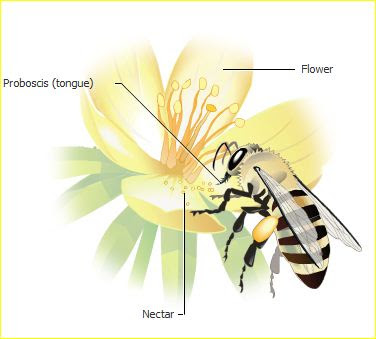Field bee collects nectar
A field bee is attracted by a flower’s brightly
colored petals and sweet scent. The field bee uses her long proboscis (tongue)
to suck up sugary nectar from the base of the flower.
Honey stomach
The field bee stores nectar in her honey stomach.
Field bees visit as many as 1,500
flowers in order to fill their honey
stomachs. When the honey stomach is full, it weighs almost as much as the bee.
The honey stomach begins to break down the sugars in the nectar to make the
nectar easier to digest.
Transfer of nectar to house bee
The field bee returns to the bee hive with a full
honey stomach. There she brings up, or regurgitates, nectar and transfers it to
a house bee using her proboscis. The house bee chews the nectar for about 30
minutes to further break down the nectar sugars.
House bee fan honey
The house bee inserts the nectar into a hive
cell. At this stage, the nectar contains mostly water. Over the next few days
house bees fan their wings over hive cells to evaporate most of the water. As
nectar loses water, it becomes thick, sticky honey.
House bee caps cell
House bees make wax to cap, or seal, the honey in
a hive cell. The honey is stored in a hive cell until it is eaten. In one year,
a colony of bees eats 54 to 90 kg (120 to 200 lb) of honey.
Post source Encarta Premium







No comments:
Post a Comment